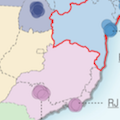Abstract
Zika virus (ZIKV) transmission in the Americas was first confirmed in April 2015 in Northeast Brazil. Brazil has the highest number of reported ZIKV cases worldwide (>200,000 by 24 Dec 2016) as well as the greatest number of cases associated with microcephaly and other birth defects (2,366 confirmed cases by 31 Dec 2016). Following the initial detection of ZIKV in Brazil, 47 countries and territories in the Americas have reported local ZIKV transmission, with 22 of these reporting ZIKV-associated severe disease. Yet the origin and epidemic history of ZIKV in Brazil and the Americas remain poorly understood, despite the value of such information for interpreting past trends in reported microcephaly. To address this we generated 53 complete or partial ZIKV genomes, mostly from Brazil, including data generated by the ZiBRA project - a mobile genomics lab that travelled across Northeast Brazil in 2016. One sequence represents the earliest confirmed ZIKV infection in Brazil. Joint analyses of viral genomes with ecological and epidemiological data estimate that the ZIKV epidemic first became established in NE Brazil by March 2014 and likely disseminated from there, both nationally and internationally, before the first detection of ZIKV in the Americas. Estimated dates of the international spread of ZIKV from Brazil coincide with periods of high vector suitability in recipient regions and indicate the duration of pre-detection cryptic transmission in those regions. NE Brazil’s role in the establishment of ZIKV in the Americas is further supported by geographic analysis of ZIKV transmission potential and by estimates of the virus’ basic reproduction number.
